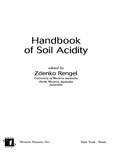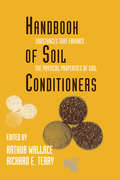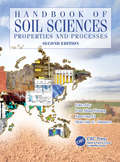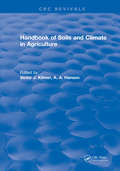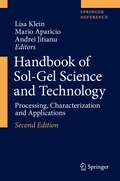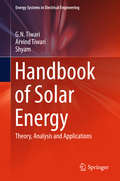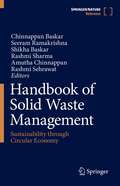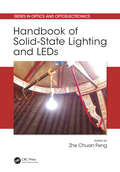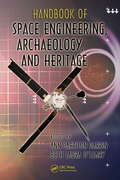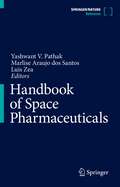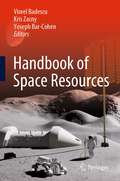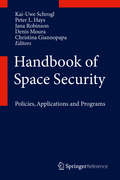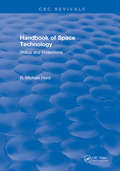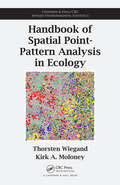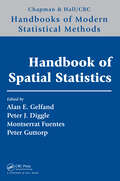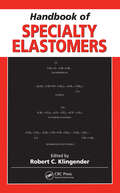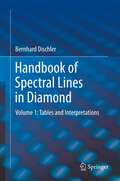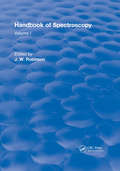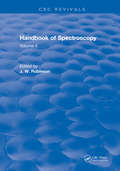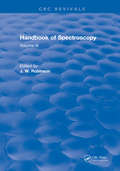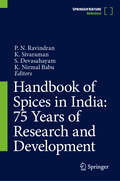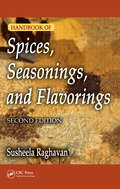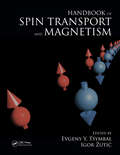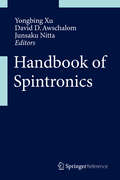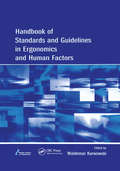- Table View
- List View
Handbook of Soil Acidity
by Zdenko RengelThis handbook offers effective strategies to modify and adjust crop production processes to decrease the toxicity of soil contaminants, balance soil pH, improve root growth and nutrient uptake, and increase agricultural yield. The Handbook of Soil Acidity provides methods to, measure soil acidity, determine the major causes of soil acidification, c
Handbook of Soil Conditioners: Substances That Enhance the Physical Properties of Soil: Substances That Enhance the Physical Properties of Soil
by WallaceThis work features scientific, technical and practical information on mineral, organic and synthetic conditioners, as well as their beneficial effects on the soil's physical properties that promote optimal plant growth, maximize soil fertility, and enhance biomediation processes. It promotes the synergistic use of various agricultural technologies to manage global concerns of decreasing arable land.
Handbook of Soil Sciences: Properties and Processes, Second Edition (Handbook of Soil Science)
by Pan Ming Huang Yuncong Li Malcolm E. SumnerAn evolving, living organic/inorganic covering, soil is in dynamic equilibrium with the atmosphere above, the biosphere within, and the geology below. It acts as an anchor for roots, a purveyor of water and nutrients, a residence for a vast community of microorganisms and animals, a sanitizer of the environment, and a source of raw materials for co
Handbook of Soils and Climate in Agriculture
by Victor J. KilmerThe sections in this handbook series reflect the input of different editors and advisory boards, and as a consequence, there is considerable variation in both the depth and coverage offered within a given area. However, an attempt has been made throughout to bring together pertinent information that will serve the needs of nonspecialists, provide a quick reference to material that might otherwise be difficult to locate, and furnish a starting point for further study.The project was undertaken with the realization that the initial volumes in the series could have some obvious deficiencies that will necessitate subsequent revisions. In the meantime, it is felt that the primary objectives of the Sections Editors and their Advisory Boards has been met in this first Edition.
Handbook of Sol-Gel Science and Technology: Processing, Characterization And Applications
by Lisa Klein Andrei Jitianu Mario AparicioThis completely updated and expanded second edition stands as a comprehensive knowledgebase on both the fundamentals and applications of this important materials processing method. The diverse, international team of contributing authors of this reference clarify in extensive detail properties and applications of sol-gel science and technology as it pertains to the production of substances, active and non-active, including optical, electronic, chemical, sensor, bio- and structural materials. Essential to a wide range of manufacturing industries, the compilation divides into the three complementary sections: Sol-Gel Processing, devoted to general aspects of processing and recently developed materials such as organic-inorganic hybrids, photonic crystals, ferroelectric coatings, and photocatalysts; Characterization of Sol-Gel Materials and Products, presenting contributions that highlight the notion that useful materials are only produced when characterization is tied to processing, such as determination of structure by NMR, in-situ characterization of the sol-gel reaction process, determination of microstructure of oxide gels, characterization of porous structure of gels by the surface measurements, and characterization of organic-inorganic hybrid; and Applications of Sol-Gel Technology, covering applications such as the sol-gel method used in processing of bulk silica glasses, bulk porous gels prepared by sol-gel method, application of sol-gel method to fabrication of glass and ceramic fibers, reflective and antireflective coating films, application of sol-gel method to formation of photocatalytic coating films, and application of sol-gel method to bioactive coating films. The comprehensive scope and integrated treatment of topics make this reference volume ideal for R&D scientists and engineers across a wide range of disciplines and professional interests.
Handbook of Solar Energy
by G. N. Tiwari Arvind Tiwari ShyamThis handbook aims at providing a comprehensive resource on solar energy. Primarily intended to serve as a reference for scientists, students and professionals, the book, in parts, can also serve as a text for undergraduate and graduate course work on solar energy. The book begins with availability, importance and applications of solar energy, definition of sun and earth angles and classification of solar energy as thermal and photon energy. It then goes onto cover day lighting parameters, laws of thermodynamics including energy and exergy analysis, photovoltaic modules and materials, PVT collectors, and applications such as solar drying and distillation. Energy conservation by solar energy and energy matrices based on overall thermal and electrical performance of hybrid system are also discussed. Techno-economic feasibility of any energy source is the backbone of its success and hence economic analysis is covered. Some important constants, such as exercises and problems increase the utility of the book as a text.
Handbook of Solid Waste Management: Sustainability through Circular Economy
by Seeram Ramakrishna Shikha Baskar Chinnappan Baskar Rashmi Sharma Amutha Chinnappan Rashmi SehrawatThe issue and finding the green solution of Solid Waste Management are important challenges throughout the world. This book explores cutting edge developments in Circular Economy and Sustainability on Solid Waste Management, current research perspectives, existing problems on solid waste management system, industrial development and the latest green methodology for in Solid Waste conversion and regenerate products and materials, environmental solutions, social awareness and development on solid waste management and the future perspectives of Circular Economy for industrial revolution 4.0 with the mission of green chemistry and engineering on solid waste management. It focuses on chapters from different researchers, faculty members, scientists and engineers, industrialist and experts from different countries working on the Circular Economy on Solid Waste Management. It also features the importance of integration of multi-disciplinary research fields on Circular Economy for Sustainable Development. It provides latest development in and current research perspectives, technology development, and critical thinking and societal requirements and development on Circular Economy of Solid Waste Management to researchers, scientists, engineers, environmental managers, policy makers, and Experts of Energy Division of Government and Private Organization and Industries.^
Handbook of Solid-State Lighting and LEDs
by Zhe Chuan FengThis handbook addresses the development of energy-efficient, environmentally friendly solid-state light sources, in particular semiconductor light emitting diodes (LEDs) and other solid-state lighting devices. It reflects the vast growth of this field and impacts in diverse industries, from lighting to communications, biotechnology, imaging, and medicine. The chapters include coverage of nanoscale processing, fabrication of LEDs, light diodes, photodetectors and nanodevices, characterization techniques, application, and recent advances. Readers will obtain an understanding of the key properties of solid-state lighting and LED devices, an overview of current technologies, and appreciation for the challenges remaining. The handbook will be useful to material growers and evaluators, device design and processing engineers, newcomers, students, and professionals in the field.
Handbook of Space Engineering, Archaeology, and Heritage (Advances in Engineering Series)
by Beth Laura O’Leary Ann Garrison DarrinSome might think that the 27 thousand tons of material launched by earthlings into outer space is nothing more than floating piles of debris. However, when looking at these artifacts through the eyes of historians and anthropologists, instead of celestial pollution, they are seen as links to human history and heritage.Space: The New Frontier for Ar
Handbook of Space Pharmaceuticals
by Yashwant V. Pathak Marlise Araujo dos Santos Luis ZeaThis handbook, directed at medical professionals and students who are involved in developing the space industry or are academicians doing research in this area, covers current pharmaceutical knowledge about the difference in medication efficacy in space versus on Earth and includes trial results and best practices for the space research and travel industry. The well-known contributors come from an interdisciplinary background and address all aspects of the subject, from the physiological impact of spaceflight to the effects of radiation.As the commercial space industry expands its operations in industry and tourism, the field of space pharmaceuticals is growing commensurately. Existing pharmacological research from space is thoroughly covered in this book, and Earth applications are also described. Potential pharmacological solutions are posed along with the known challenges and examples from existing studies, which are detailed at length. This major reference work is a comprehensive and important medical resource for all space industry players.
Handbook of Space Resources
by Yoseph Bar-Cohen Viorel Badescu Kris ZacnyEarth has limited material and energy resources, while these resources are virtually unlimited in space. It is only a matter of time, before planetary resources are mined and used in-situ to sustain human and robotic exploration or returned to Earth for commercial gain. This book covers a number of aspects related to space resources. In particular, subjects related to mission concepts, exploration approaches, mining and extraction technologies, commercial potential, and regulatory aspects of space resources are covered in detail. This book is therefore a good resource for readers who seek background and deeper understanding of space resources related activities.
Handbook of Space Security
by Kai-Uwe Schrogl Peter L. Hays Jana Robinson Denis Moura Christina GiannopapaSpace Security involves the use of space (in particular communication, navigation, earth observation, and electronic intelligence satellites) for military and security purposes on earth and also the maintenance of space (in particular the earth orbits) as safe and secure areas for conducting peaceful activities. The two aspects can be summarized as "space for security on earth" and the safeguarding of space for peaceful endeavors. The Handbook will provide a sophisticated, cutting-edge resource on the space security policy portfolio and the associated assets, assisting fellow members of the global space community and other interested policy-making and academic audiences in keeping abreast of the current and future directions of this vital dimension of international space policy. The debate on coordinated space security measures, including relevant 'Transparency and Confidence-Building Measures, ' remains at a relatively early stage of development. The book offers a comprehensive description of the various components of space security and how these challenges are being addressed today. It will also provide a number of recommendations concerning how best to advance this space policy area, given the often competing objectives of the world's major space-faring nations. The critical role to be played by the United States and Europe as an intermediary and "middle diplomat" in promoting sustainable norms of behavior for space will likewise be highlighted. In providing a global and coherent analytical approach to space security today, theHandbook focuses on four areas that together define the entire space security area: policies, technologies, applications, and programs. This structure will assure the overall view of the subject from its political to its technical aspects. Internationally recognized experts in each of the above fields contribute, with their analytical synthesis assured by the section editors. "
Handbook of Space Technology: Status and Projections
by R. Michael HordThis book presents current and anticipated quantitative values for a wide range of cirtical figures of merit which characterize technological capabilities in the major discipline areas of space technology. The projections are based on historical data and the considered opinions of knowledgable experts in government and industry who are active contributors in their respective fields.
Handbook of Spatial Point-Pattern Analysis in Ecology (Chapman & Hall/CRC Applied Environmental Statistics)
by Thorsten Wiegand Kirk A. MoloneyThis handbook shows how the techniques of point-pattern analysis are useful for tackling ecological problems. Within an ecological framework, it guides readers through a variety of methods for different data types and aids in the interpretation of the results obtained by point-pattern analysis. Along with the techniques, the book provides a comprehensive selection of real-world examples. Most of the examples are analyzed using the authors' software package Programita. The software and a manual are available online.
Handbook of Spatial Statistics (Chapman & Hall/CRC Handbooks of Modern Statistical Methods)
by Peter J. Diggle Peter Guttorp Alan E. Gelfand Montserrat FuentesAssembling a collection of very prominent researchers in the field, the Handbook of Spatial Statistics presents a comprehensive treatment of both classical and state-of-the-art aspects of this maturing area. It takes a unified, integrated approach to the material, providing cross-references among chapters.The handbook begins with a historical intro
Handbook of Specialty Elastomers
by Robert C. KlingenderWritten and edited by experts on specialty elastomers applications in the mechanical and automotive products industries, the Handbook of Specialty Elastomers provides a single source reference for the design of compounds using specialty elastomers.This book defines specialty elastomers as heat-, oil-, fuel-, and solvent-resistant polymer
Handbook of Spectral Lines in Diamond
by Bernhard DischlerThis handbook is a breakthrough in the understanding of the large number of spectral lines in diamond. Data on more than 2000 lines and bands are presented in 200 tables, including many unpublished results. With a novel organization scheme, the search for a specific line is greatly simplified as a benefit for researchers and students. In order to meet the interest in the understanding of the spectra, structure assignments for 80 % of the lines are given, of which 15 % only were published before. The majority of the structures for the 300 centers is explained in most cases for the first time. A key instrument in the interpretation is the analysis by donor-acceptor pair transitions. In a special chapter 95 such centers are listed and discussed, of which only two have been published before, the first one by the present author in 1994.
Handbook of Spectroscopy: Volume I
by J. W. RobinsonThe principle objective of this handbook is to provide a readily accessible source of information on the major fields of spectroscopy. Specifically, these fields are NMR, IR, Raman, UV (absorption and fluorescence), ESCA, X-Ray (absorption diffraction fluorescence), mass spectrometry, atomic absorption, flame photometry, emission spectrography, and flame spectroscopy. It will be of particular use to analytical, organic, inorganic chemists or spectroscopists wishing to identify materials or compounds. The book will indicate to them which techniques may provide useful information and what kind of information will and will not be provided. In short, it will be a companion to those spectroscopists who have need to broaden their horizons into the major fields discussed.
Handbook of Spectroscopy: Volume II
by J. W. RobinsonThe principle objective of this handbook is to provide a readily accessible source of information on the major fields of spectroscopy. Specifically, these fields are NMR, IR, Raman, UV (absorption and fluorescence), ESCA, X-Ray (absorption diffraction fluorescence), mass spectrometry, atomic absorption, flame photometry, emission spectrography, and flame spectroscopy. It will be of particular use to analytical, organic, inorganic chemists or spectroscopists wishing to identify materials or compounds. The book will indicate to them which techniques may provide useful information and what kind of information will and will not be provided. In short, it will be a companion to those spectroscopists who have need to broaden their horizons into the major fields discussed.
Handbook of Spectroscopy: Volume III
by J. W. RobinsonThe principle objective of this handbook is to provide a readily accessible source of information on the major fields of spectroscopy. Specifically, these fields are NMR, IR, Raman, UV (absorption and fluorescence), ESCA, X-Ray (absorption diffraction fluorescence), mass spectrometry, atomic absorption, flame photometry, emission spectrography, and flame spectroscopy. It will be of particular use to analytical, organic, inorganic chemists or spectroscopists wishing to identify materials or compounds. The book will indicate to them which techniques may provide useful information and what kind of information will and will not be provided. In short, it will be a companion to those spectroscopists who have need to broaden their horizons into the major fields discussed.
Handbook of Spices in India: 75 Years of Research and Development
by P. N. Ravindran K. Nirmal Babu K. Sivaraman S. DevasahayamThis compendium presents comprehensive information on more than 25 important spice crops commercially grown in India and traded globally, apart from over 40 spices that have the potential to be popularized. In 70 chapters the book covers the achievements in research and development made in India for the past 75 years in various organizations including research institutes, agricultural universities and private sector laboratories. Spices are natural products of plant origin, used primarily for flavouring and seasoning or for adding pungency and flavour to foods and beverages. The flavour and fragrance of Indian spices had a magic spell on human culture since very ancient days. The importance of spices in Indian life and its contribution to the economy are substantial. India, as the world’s leading producer of spices is also a significant stakeholder in spices export trade globally. Indian spices being sources of many high value compounds, are also gaining muchimportance for other diversified uses especially for their pharmaceutical and nutraceutical properties. A wide variety of 52 spices are grown in India including black pepper, chillies, cardamom, ginger, turmeric, cinnamon, nutmeg, garlic, onion, cumin, coriander, saffron and vanilla. This book complies a comprehensive, holistic review on the subject, written by the best experts in the field in India representing diverse agencies. This book is a single point reference book for all those involved in the research, study, teaching and use of spices in India and abroad.
Handbook of Spices, Seasonings, and Flavorings
by Susheela RaghavanAn A to Z Catalog of Innovative Spices and FlavoringsDesigned to be a practical tool for the many diverse professionals who develop and market foods, the Handbook of Spices, Seasonings, and Flavorings combines technical information about spices-forms, varieties, properties, applications, and quality specifications- with informatio
Handbook of Spin Transport and Magnetism
by Evgeny Y. Tsymbal Igor ŽutićIn the past several decades, the research on spin transport and magnetism has led to remarkable scientific and technological breakthroughs, including Albert Fert and Peter Grunberg's Nobel Prize-winning discovery of giant magnetoresistance (GMR) in magnetic metallic multilayers. Handbook of Spin Transport and Magnetism provides a comprehensive, bal
Handbook of Spintronics
by Yongbing Xu David D. Awschalom Junsaku NittaOver two volumes and 1500 pages, the Handbook of Spintronics will cover all aspects of spintronics science and technology, including fundamental physics, materials properties and processing, established and emerging device technology and applications. Comprising 60 chapters from a large international team of leading researchers across academia and industry, the Handbook provides readers with an up-to-date and comprehensive review of this dynamic field of research. The opening chapters focus on the fundamental physical principles of spintronics in metals and semiconductors, including an introduction to spin quantum computing. Materials systems are then considered, with sections on metallic thin films and multilayers, magnetic tunnelling structures, hybrids, magnetic semiconductors and molecular spintronic materials. A separate section reviews the various characterisation methods appropriate to spintronics materials, including STM, spin-polarised photoemission, x-ray diffraction techniques and spin-polarised SEM. The third part of the Handbook contains chapters on the state of the art in device technology and applications, including spin valves, GMR and MTJ devices, MRAM technology, spin transistors and spin logic devices, spin torque devices, spin pumping and spin dynamics and other topics such as spin caloritronics. Each chapter considers the challenges faced by researchers in that area and contains some indications of the direction that future work in the field is likely to take. This reference work will be an essential and long-standing resource for the spintronics community.
Handbook of Standards and Guidelines in Ergonomics and Human Factors
by Waldema KarwowskiA comprehensive review of international and national standards and guidelines, this handbook consists of 32 chapters divided into nine sections that cover standardization efforts, anthropometry and working postures, designing manual material, human-computer interaction, occupational health and safety, legal protection, military human factor standar
